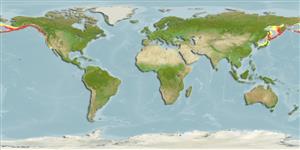Teleostei (teleosts) >
Perciformes/Scorpaenoidei (Scorpionfishes) >
Sebastidae (Rockfishes, rockcods and thornyheads) > Sebastinae
Etymology: Sebastes: Greek, sebastes = august, venerable (Ref. 45335); aleutianus: Named after the Aleutian Islands in Alaska (Ref. 6885).
More on authors: Jordan & Evermann.
Environment: milieu / climate zone / depth range / distribution range
Ecology
Marine; bathydemersal; depth range 25 - 900 m (Ref. 50610). Deep-water; 66°N - 32°N, 129°E - 116°W
North Pacific: Japan to Navarin Canyon in the Bering Sea (but not in the Sea of Okhotsk), throughout the Aleutian Islands, and south to San Diego, California, USA.
Length at first maturity / Size / Weight / Age
Maturity: Lm 47.0 range ? - ? cm
Max length : 97.0 cm TL male/unsexed; (Ref. 9015); max. published weight: 900.00 g (Ref. 40637); max. reported age: 205 years (Ref. 55701)
Dorsal spines (total): 12 - 14; Dorsal soft rays (total): 14; Anal spines: 3; Anal soft rays: 6 - 8; Vertebrae: 27. This species is distinguished by the following characters: 8 head spines strong - nasal, preocular, supraocular, postocular, tympanic, coronal, parietal and nuchal spines; 2 or more infraorbital spines; differs from S. melanostictus by having a pale body with no distinct spots on the membranes of the spinous dorsal fin; shorter dorsal-fin spine 1, 1.5?3.0 times into orbit length, 4.3?7.2% SL (vs. 1.0?1.8 times into orbit length and 5.9?9.6% SL); shorter dorsal-fin spine 4, 9.8?15.5% SL (vs. 12.0?18.4% SL); shorter and fewer gill rakers, 3.4?6.3% SL (vs. 3.9?7.1% SL) and 29?34 (vs. 30?36), respectively (Ref. 87139).
Usually found offshore (Ref. 27437). Viviparous (Ref. 34817).
Eschmeyer, W.N., E.S. Herald and H. Hammann, 1983. A field guide to Pacific coast fishes of North America. Boston (MA, USA): Houghton Mifflin Company. xii+336 p. (Ref. 2850)
IUCN Red List Status (Ref. 130435)
Threat to humans
Harmless
Human uses
Fisheries: commercial
Tools
Special reports
Download XML
Internet sources
Estimates based on models
Preferred temperature (Ref.
123201): 1.1 - 6.6, mean 3.8 °C (based on 232 cells).
Phylogenetic diversity index (Ref.
82804): PD
50 = 0.5000 [Uniqueness, from 0.5 = low to 2.0 = high].
Bayesian length-weight: a=0.00851 (0.00542 - 0.01337), b=3.12 (2.99 - 3.25), in cm total length, based on LWR estimates for this species & Genus-body shape (Ref.
93245).
Trophic level (Ref.
69278): 3.5 ±0.2 se; based on diet studies.
Generation time: 18.3 ( na - na) years. Estimated as median ln(3)/K based on 2
growth studies.
Resilience (Ref.
120179): Very Low, minimum population doubling time more than 14 years (tmax=205).
Prior r = 0.03, 95% CL = 0.02 - 0.05, Based on 1 full stock assessment.
Fishing Vulnerability (Ref.
59153): High to very high vulnerability (74 of 100).
Nutrients (Ref.
124155): Calcium = 11.9 [4.4, 36.8] mg/100g; Iron = 0.229 [0.094, 0.634] mg/100g; Protein = 17.4 [16.2, 18.8] %; Omega3 = 0.635 [0.243, 1.657] g/100g; Selenium = 55.3 [18.9, 166.5] μg/100g; VitaminA = 8.1 [1.9, 35.6] μg/100g; Zinc = 0.287 [0.150, 0.547] mg/100g (wet weight);
